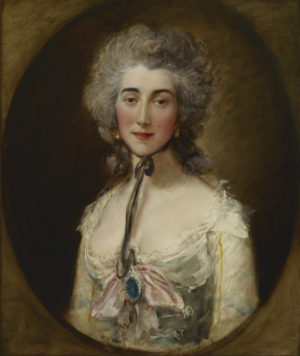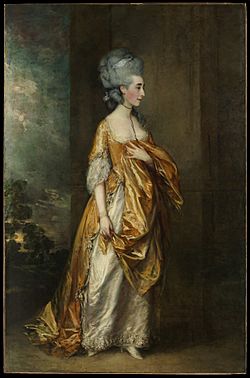Grace Elliott facts for kids
Quick facts for kids
Grace Elliott
|
|
|---|---|

Portrait of Grace Elliott by Thomas Gainsborough, circa 1778 (in the Frick Collection)
|
|
| Born |
Grace Dalrymple
c. 1754 Edinburgh, Scotland
|
| Died | 16 May 1823 (aged 68–69) Ville d'Avray, France
|
| Burial place | Père Lachaise Cemetery, Paris |
| Nationality | Scottish |
| Occupation | Writer, spy |
| Known for | companion of the Louis Philippe II, Duke of Orléans |
|
Notable work
|
Journal of my life during the French Revolution |
| Spouse(s) | Sir John Eliot (divorced) |
| Children | Georgina Seymour |
| Parent(s) | Grisel Craw (mother) Hew Dalrymple (father) |
Grace Dalrymple Elliott (born around 1754 – died May 16, 1823) was a Scottish writer and secret agent. She lived in Paris during the exciting and dangerous time of the French Revolution.
She wrote down what she saw and experienced in her book, Journal of my life during the French Revolution. This book was published after her death in 1859. Grace Elliott was a close friend and companion of the Duke of Orléans. She also had a daughter with the future King George IV of Great Britain.
Grace Elliott secretly carried messages and helped French noble families escape the dangers of the French Revolution. She was arrested many times but managed to avoid the guillotine, a machine used for executions. She was finally set free after the death of Robespierre, a powerful leader of the Revolution.
Contents
Early Life and Marriage
Grace Elliott was likely born in Edinburgh, Scotland, around 1754. She was the youngest daughter of Grissel Brown and Hew Dalrymple. Her father was a lawyer in Edinburgh.
Her parents separated when she was very young. Grace probably grew up in her grandparents' home. She went to school in a French convent, which is a type of religious school.
When she returned to Scotland, her father introduced her to society. Her beauty impressed John Eliot, a rich and famous doctor. He asked her to marry him in 1771. Grace accepted, even though Eliot was about 18 years older than her. They got married in London on October 19, 1771, when she was 17.
The couple became part of fashionable society. However, they eventually grew apart and divorced. This was mainly because of their age difference and different interests.
Life in England and Her Daughter
In 1776, Grace Elliott met Lord Cholmondeley at the Pantheon in London. They had a relationship that lasted for three years.
The famous artist Thomas Gainsborough painted two portraits of her in 1778. These paintings can now be seen in the Frick Collection and the Metropolitan Museum of Art.
In 1782, she had a brief relationship with the Prince of Wales. He later became King George IV. On March 30, 1782, Grace gave birth to a daughter. Her daughter was named Georgiana Augusta Frederica Seymour and was known as Georgina Seymour.
Lord Cholmondeley helped raise Georgina. After Georgina's early death in 1813, he also took care of her only child.
Life in France During the Revolution

In 1784, the Prince of Wales introduced Grace to the French Duke of Orléans. By 1786, she had moved to Paris permanently.
Most of what we know about Grace Elliott's life in France comes from her own book. It is called Journal of my life during the French Revolution. Even though there are some small differences in her story, her book is one of the most famous English accounts of The Terror. This was a very violent period of the French Revolution.
Her book describes the activities of the Duke of Orléans and his noble friends. Grace Elliott saw terrible events, like the September massacres. She saw the body of the Princess de Lamballe being carried through the streets.
Even though Grace was friends with the Duke of Orléans, her support for the royal family became known. Her home was often searched by the Revolutionary government. It has been discovered that Grace Elliott was secretly carrying messages for the British government. She helped send messages between Paris and French nobles who had fled to places like Coblenz and Belgium.
Helping Those in Danger
Grace Elliott risked her life many times to help and hide nobles who were being hunted by the Revolutionary government. After the attack on the Tuileries Palace on August 10, 1792, she hid the injured Marquis de Champcentz. She carried him to her house and hid him between the mattresses of her bed. She pretended to be sick when her house was searched.
Another time, Grace agreed to hide Madame de Perigord and her two children at her home in Meudon. They were trying to escape to England. Grace helped arrange fake travel documents for several people who wanted to leave France. After hiding Champcentz in her attic, she helped him escape the country.
However, in the spring of 1793, Grace Elliott was arrested and put in prison. She spent the rest of The Terror in different prisons, including the Recollets and the Carmes. She wrote about her difficult prison experiences. She described the harsh treatment she faced and the sickness and lack of food suffered by other prisoners.
Later Life and Legacy
Many of Grace Elliott's friends, including Madame du Barry, died during the Revolution. But Grace herself narrowly escaped death. She was released after the Reign of Terror ended. She had been held in four different prisons by the government.
Grace Elliott died a wealthy woman in Ville d'Avray, France, in May 1823. She was staying with the town's mayor at the time. She was buried in Père Lachaise Cemetery in Paris.
Depictions in Film and Literature
Part of Grace Elliott's life is shown in the 2001 film The Lady and the Duke by Eric Rohmer. The English actress Lucy Russell played Grace Elliott. Jean-Claude Dreyfus played the Duke of Orléans.
Grace Elliott also appears as an important character in Hallie Rubenhold's novel The French Lesson, published in 2016.

